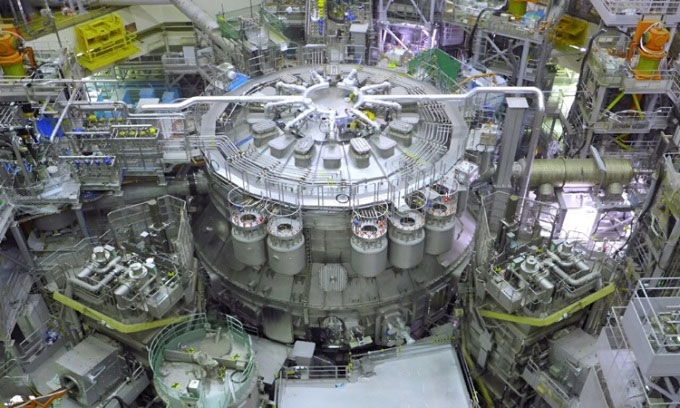Japan inaugurated the world's largest fusion reactor
The JT-60SA reactor, as tall as 6 buildings in Japan, will create plasma as hot as 200 million degrees Celsius, paving the way for the goal of obtaining net energy from fusion reactions.
The world's largest experimental fusion reactor in operation was inaugurated in Japan on December 1. Although still young, this technology promises to become a solution for humanity's energy needs in the future, according to Phys.org .

The JT-60SA reactor is the world's largest experimental fusion reactor. (Photo: Phys.org)
Fusion energy differs from the fission energy used in nuclear power plants today in that the reaction fuses two nuclear atoms instead of splitting them in half. The goal of the JT-60SA reactor is to test the feasibility of fusion as a safe, deployable, large-scale, carbon-neutral energy source, while producing more energy than is currently needed. consumption (net energy).
The machine is as tall as a six-storey building located in a warehouse in Naka, north of Tokyo, and includes an annular tokamak furnace, used to hold a rotating stream of plasma hot up to 200 million degrees Celsius. This is a joint project between the Alliance Europe and Japan, the predecessor of a larger version in France is under construction called the International Thermal Nuclear Experimental Reactor (ITER). The ultimate goal of both projects is to force hydrogen atoms to fuse into the heavier element helium, releasing energy in the form of light and water, simulating the process that takes place inside the Sun. The research team at ITER hopes to achieve the ultimate goal of fusion technology, which is net energy.
Sam Davis, deputy leader of the JT-60SA project team, said the device will bring humans closer to fusion energy. It is the result of collaboration between more than 500 scientists, engineers and more than 700 companies across Europe and Japan. European Union Energy Commissioner Kadri Simson describes the JT-60SA as the world's most advanced tokamak furnace.
The National Ignition Facility at Lawrence Livermore Laboratory in the US achieved a net energy gain last December. They used a method different from the ITER and JT-60SA furnaces, called inertial confinement fusion , in which high-energy laser beams simultaneously hit a small cylinder containing hydrogen. The US government calls this result an important achievement in the quest to conquer limitless clean energy sources, ending dependence on carbon-emitting fossil fuels that cause climate change. Unlike fission, fusion has less risk of accidents and produces less radioactive waste than current power plants.
- Korea's fusion reactor is 7 times hotter than the Sun's core
- Successfully built Stellarator-type thermonuclear reactor
- Ambition to harness energy from fusion reactions
- The world's largest magnet can lift an aircraft carrier
- Pouring 1 billion yuan, China 'fired a laser' at the fusion empire of nearly 50 billion dollars
- Grid fusion synthesis power in 2050
- Why are China and many countries racing to make artificial sun?
- The supersonic aircraft is equipped with a fusion reactor
- Fusion reactor hits 100 million degrees Celsius
- The mystery behind the arc reactor in the Iron Man armor
- Going to start the project
- Superheated helium balloons,
 Norway built the world's tallest wooden tower
Norway built the world's tallest wooden tower Kremlin
Kremlin Ashurbanipal: The oldest royal library in the world
Ashurbanipal: The oldest royal library in the world Decoding the thousand-year construction of Qin Shihuang shocked the world
Decoding the thousand-year construction of Qin Shihuang shocked the world